
openrl
Unified Reinforcement Learning Framework
Stars: 577
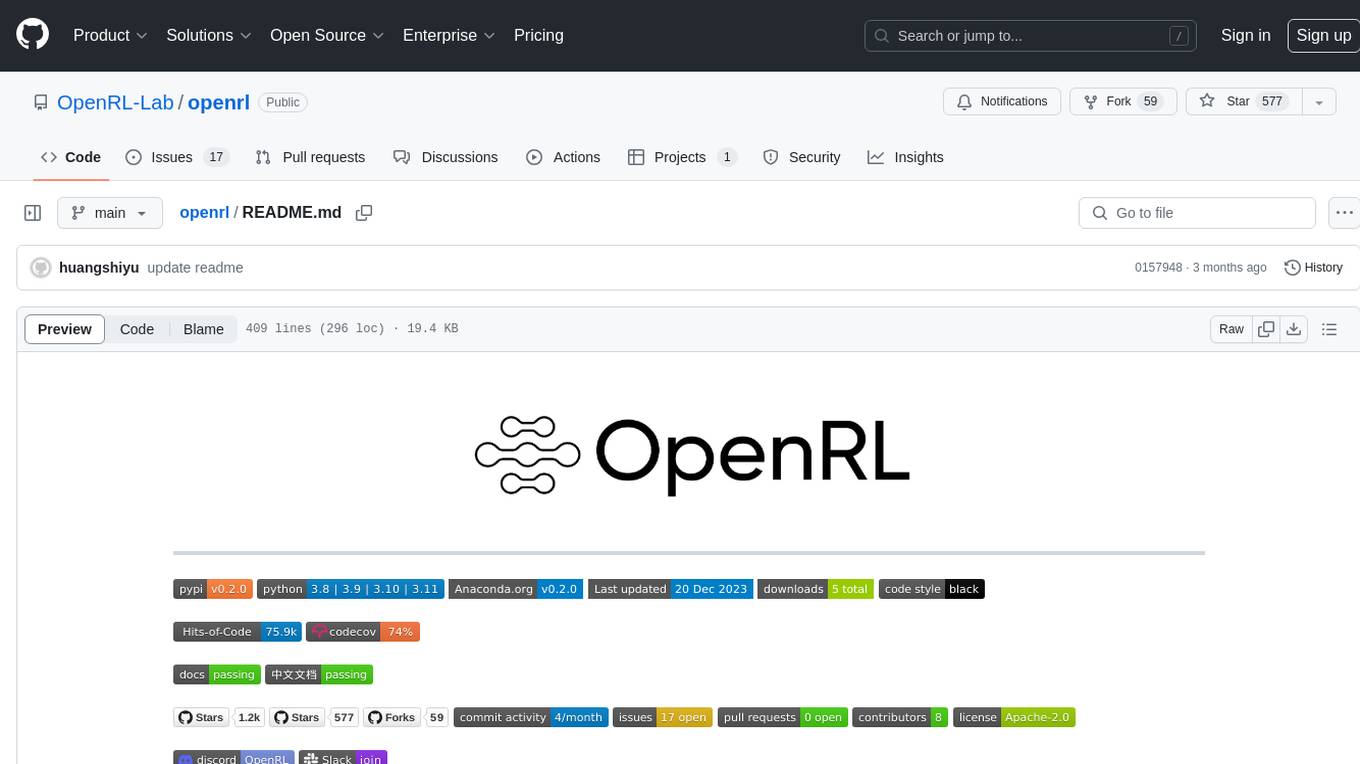
OpenRL is an open-source general reinforcement learning research framework that supports training for various tasks such as single-agent, multi-agent, offline RL, self-play, and natural language. Developed based on PyTorch, the goal of OpenRL is to provide a simple-to-use, flexible, efficient and sustainable platform for the reinforcement learning research community. It supports a universal interface for all tasks/environments, single-agent and multi-agent tasks, offline RL training with expert dataset, self-play training, reinforcement learning training for natural language tasks, DeepSpeed, Arena for evaluation, importing models and datasets from Hugging Face, user-defined environments, models, and datasets, gymnasium environments, callbacks, visualization tools, unit testing, and code coverage testing. It also supports various algorithms like PPO, DQN, SAC, and environments like Gymnasium, MuJoCo, Atari, and more.
README:
OpenRL-v0.2.1 is updated on Dec 20, 2023
The main branch is the latest version of OpenRL, which is under active development. If you just want to have a try with OpenRL, you can switch to the stable branch.
Documentation | 中文介绍 | 中文文档
OpenRL is an open-source general reinforcement learning research framework that supports training for various tasks such as single-agent, multi-agent, offline RL, self-play, and natural language. Developed based on PyTorch, the goal of OpenRL is to provide a simple-to-use, flexible, efficient and sustainable platform for the reinforcement learning research community.
Currently, the features supported by OpenRL include:
-
A simple-to-use universal interface that supports training for all tasks/environments
-
Support for both single-agent and multi-agent tasks
-
Support for offline RL training with expert dataset
-
Support self-play training
-
Reinforcement learning training support for natural language tasks (such as dialogue)
-
Support DeepSpeed
-
Support Arena , which allows convenient evaluation of various agents (even submissions for JiDi) in a competitive environment.
-
Importing models and datasets from Hugging Face. Supports loading Stable-baselines3 models from Hugging Face for testing and training.
-
Tutorial on how to integrate user-defined environments into OpenRL.
-
Support for models such as LSTM, GRU, Transformer etc.
-
Multiple training acceleration methods including automatic mixed precision training and data collecting wth half precision policy network
-
User-defined training models, reward models, training data and environment support
-
Support for gymnasium environments
-
Support for Callbacks, which can be used to implement various functions such as logging, saving, and early stopping
-
Dictionary observation space support
-
Popular visualization tools such as wandb, tensorboardX are supported
-
Serial or parallel environment training while ensuring consistent results in both modes
-
Chinese and English documentation
-
Provides unit testing and code coverage testing
-
Compliant with Black Code Style guidelines and type checking
Algorithms currently supported by OpenRL (for more details, please refer to Gallery):
- Proximal Policy Optimization (PPO)
- Dual-clip PPO
- Multi-agent PPO (MAPPO)
- Joint-ratio Policy Optimization (JRPO)
- Generative Adversarial Imitation Learning (GAIL)
- Behavior Cloning (BC)
- Advantage Actor-Critic (A2C)
- Self-Play
- Deep Q-Network (DQN)
- Multi-Agent Transformer (MAT)
- Value-Decomposition Network (VDN)
- Soft Actor Critic (SAC)
- Deep Deterministic Policy Gradient (DDPG)
Environments currently supported by OpenRL (for more details, please refer to Gallery):
- Gymnasium
- MuJoCo
- PettingZoo
- MPE
- Chat Bot
- Atari
- StarCraft II
- SMACv2
- Omniverse Isaac Gym
- DeepMind Control
- Snake
- gym-pybullet-drones
- EnvPool
- GridWorld
- Super Mario Bros
- Gym Retro
- Crafter
This framework has undergone multiple iterations by the OpenRL-Lab team which has applied it in academic research. It has now become a mature reinforcement learning framework.
OpenRL-Lab will continue to maintain and update OpenRL, and we welcome everyone to join our open-source community to contribute towards the development of reinforcement learning.
For more information about OpenRL, please refer to the documentation.
- Welcome to OpenRL
- Outline
- Why OpenRL?
- Installation
- Use Docker
- Quick Start
- Gallery
- Projects Using OpenRL
- Feedback and Contribution
- Maintainers
- Supporters
- Citing OpenRL
- License
- Acknowledgments
Here we provide a table for the comparison of OpenRL and existing popular RL libraries. OpenRL employs a modular design and high-level abstraction, allowing users to accomplish training for various tasks through a unified and user-friendly interface.
| Library | NLP/RLHF | Multi-agent | Self-Play Training | Offline RL | DeepSpeed |
|---|---|---|---|---|---|
| OpenRL | ✔️ | ✔️ | ✔️ | ✔️ | ✔️ |
| Stable Baselines3 | ❌ | ❌ | ❌ | ❌ | ❌ |
| Ray/RLlib | ❌ | ✔️ | ✔️ | ✔️ | ❌ |
| DI-engine | ❌ | ✔️ | not fullly supported | ✔️ | ❌ |
| Tianshou | ❌ | not fullly supported | not fullly supported | ✔️ | ❌ |
| MARLlib | ❌ | ✔️ | not fullly supported | ❌ | ❌ |
| MAPPO Benchmark | ❌ | ✔️ | ❌ | ❌ | ❌ |
| RL4LMs | ✔️ | ❌ | ❌ | ❌ | ❌ |
| trlx | ✔️ | ❌ | ❌ | ❌ | ✔️ |
| trl | ✔️ | ❌ | ❌ | ❌ | ✔️ |
| TimeChamber | ❌ | ❌ | ✔️ | ❌ | ❌ |
Users can directly install OpenRL via pip:
pip install openrlIf users are using Anaconda or Miniconda, they can also install OpenRL via conda:
conda install -c openrl openrlUsers who want to modify the source code can also install OpenRL from the source code:
git clone https://github.com/OpenRL-Lab/openrl.git && cd openrl
pip install -e .After installation, users can check the version of OpenRL through command line:
openrl --versionTips: No installation required, try OpenRL online through
Colab:
OpenRL currently provides Docker images with and without GPU support. If the user's computer does not have an NVIDIA GPU, they can obtain an image without the GPU plugin using the following command:
sudo docker pull openrllab/openrl-cpuIf the user wants to accelerate training with a GPU, they can obtain it using the following command:
sudo docker pull openrllab/openrlAfter successfully pulling the image, users can run OpenRL's Docker image using the following commands:
# Without GPU acceleration
sudo docker run -it openrllab/openrl-cpu
# With GPU acceleration
sudo docker run -it --gpus all --net host openrllab/openrlOnce inside the Docker container, users can check OpenRL's version and then run test cases using these commands:
# Check OpenRL version in Docker container
openrl --version
# Run test case
openrl --mode train --env CartPole-v1 OpenRL provides a simple and easy-to-use interface for beginners in reinforcement learning.
Below is an example of using the PPO algorithm to train the CartPole environment:
# train_ppo.py
from openrl.envs.common import make
from openrl.modules.common import PPONet as Net
from openrl.runners.common import PPOAgent as Agent
env = make("CartPole-v1", env_num=9) # Create an environment and set the environment parallelism to 9.
net = Net(env) # Create neural network.
agent = Agent(net) # Initialize the agent.
agent.train(
total_time_steps=20000) # Start training and set the total number of steps to 20,000 for the running environment.Training an agent using OpenRL only requires four simple steps: Create Environment => Initialize Model => Initialize Agent => Start Training!
For a well-trained agent, users can also easily test the agent:
# train_ppo.py
from openrl.envs.common import make
from openrl.modules.common import PPONet as Net
from openrl.runners.common import PPOAgent as Agent
agent = Agent(Net(make("CartPole-v1", env_num=9))) # Initialize trainer.
agent.train(total_time_steps=20000)
# Create an environment for test, set the parallelism of the environment to 9, and set the rendering mode to group_human.
env = make("CartPole-v1", env_num=9, render_mode="group_human")
agent.set_env(env) # The agent requires an interactive environment.
obs, info = env.reset() # Initialize the environment to obtain initial observations and environmental information.
while True:
action, _ = agent.act(obs) # The agent predicts the next action based on environmental observations.
# The environment takes one step according to the action, obtains the next observation, reward, whether it ends and environmental information.
obs, r, done, info = env.step(action)
if any(done): break
env.close() # Close test environmentExecuting the above code on a regular laptop only takes a few seconds to complete the training. Below shows the visualization of the agent:
Tips: Users can also quickly train the CartPole environment by executing a command line in the terminal.
openrl --mode train --env CartPole-v1For training tasks such as multi-agent and natural language processing, OpenRL also provides a similarly simple and easy-to-use interface.
For information on how to perform multi-agent training, set hyperparameters for training, load training configurations, use wandb, save GIF animations, etc., please refer to:
For information on natural language task training, loading models/datasets on Hugging Face, customizing training models/reward models, etc., please refer to:
For more information about OpenRL, please refer to the documentation.
In order to facilitate users' familiarity with the framework, we provide more examples and demos of using OpenRL in Gallery. Users are also welcome to contribute their own training examples and demos to the Gallery.
We have listed research projects that use OpenRL in the OpenRL Project. If you are using OpenRL in your research project, you are also welcome to join this list.
- If you have any questions or find bugs, you can check or ask in the Issues.
- Join the QQ group: OpenRL Official Communication Group
- Join the slack group to discuss OpenRL usage and development with us.
- Join the Discord group to discuss OpenRL usage and development with us.
- Send an E-mail to: [email protected]
- Join the GitHub Discussion.
The OpenRL framework is still under continuous development and documentation. We welcome you to join us in making this project better:
- How to contribute code: Read the Contributors' Guide
- OpenRL Roadmap
At present, OpenRL is maintained by the following maintainers:
- Shiyu Huang(@huangshiyu13)
- Wenze Chen(@WentseChen)
- Yiwen Sun(@YiwenAI)
Welcome more contributors to join our maintenance team (send an E-mail to [email protected] to apply for joining the OpenRL team).
If our work has been helpful to you, please feel free to cite us:
@article{huang2023openrl,
title={OpenRL: A Unified Reinforcement Learning Framework},
author={Huang, Shiyu and Chen, Wentse and Sun, Yiwen and Bie, Fuqing and Tu, Wei-Wei},
journal={arXiv preprint arXiv:2312.16189},
year={2023}
}OpenRL under the Apache 2.0 license.
The development of the OpenRL framework has drawn on the strengths of other reinforcement learning frameworks:
- Stable-baselines3: https://github.com/DLR-RM/stable-baselines3
- pytorch-a2c-ppo-acktr-gail: https://github.com/ikostrikov/pytorch-a2c-ppo-acktr-gail
- MAPPO: https://github.com/marlbenchmark/on-policy
- Gymnasium: https://github.com/Farama-Foundation/Gymnasium
- DI-engine: https://github.com/opendilab/DI-engine/
- Tianshou: https://github.com/thu-ml/tianshou
- RL4LMs: https://github.com/allenai/RL4LMs
For Tasks:
Click tags to check more tools for each tasksFor Jobs:
Alternative AI tools for openrl
Similar Open Source Tools

openrl
OpenRL is an open-source general reinforcement learning research framework that supports training for various tasks such as single-agent, multi-agent, offline RL, self-play, and natural language. Developed based on PyTorch, the goal of OpenRL is to provide a simple-to-use, flexible, efficient and sustainable platform for the reinforcement learning research community. It supports a universal interface for all tasks/environments, single-agent and multi-agent tasks, offline RL training with expert dataset, self-play training, reinforcement learning training for natural language tasks, DeepSpeed, Arena for evaluation, importing models and datasets from Hugging Face, user-defined environments, models, and datasets, gymnasium environments, callbacks, visualization tools, unit testing, and code coverage testing. It also supports various algorithms like PPO, DQN, SAC, and environments like Gymnasium, MuJoCo, Atari, and more.
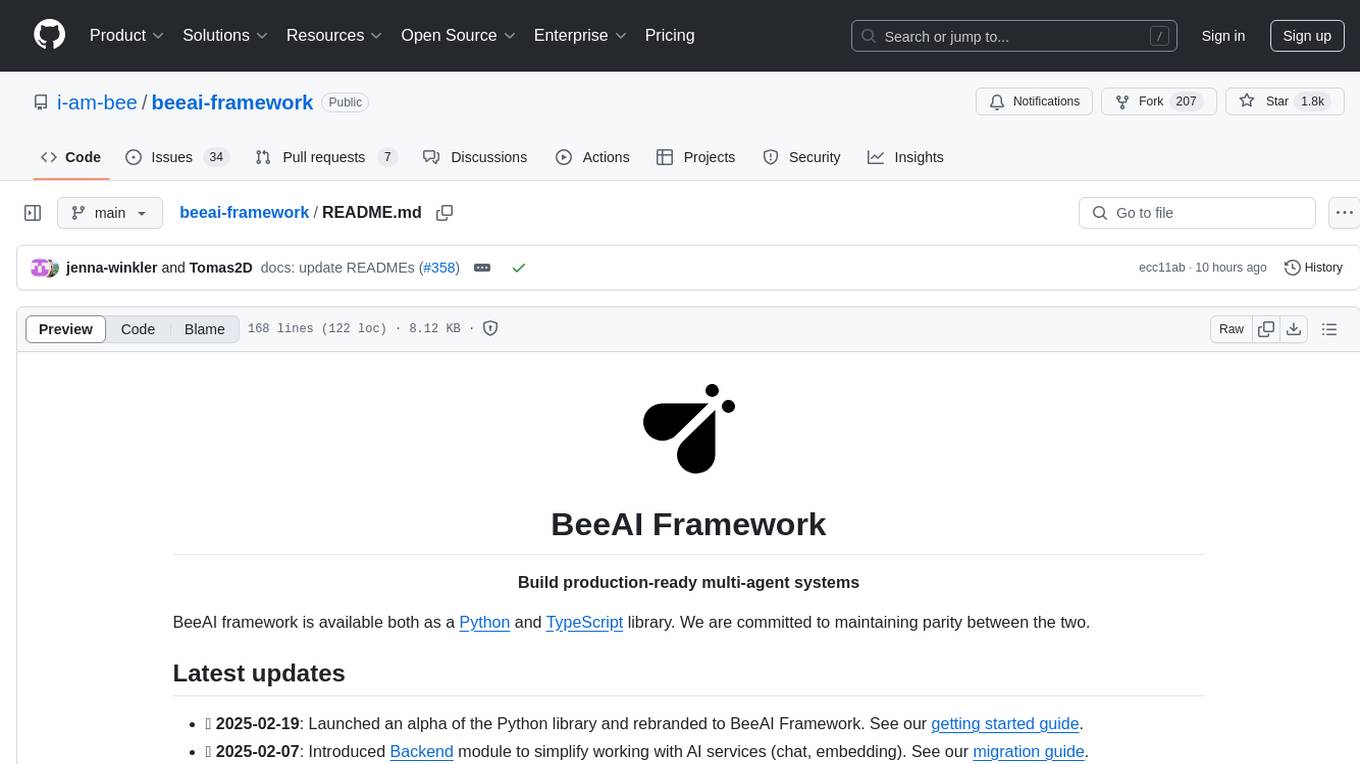
beeai-framework
BeeAI Framework is a versatile tool for building production-ready multi-agent systems. It offers flexibility in orchestrating agents, seamless integration with various models and tools, and production-grade controls for scaling. The framework supports Python and TypeScript libraries, enabling users to implement simple to complex multi-agent patterns, connect with AI services, and optimize token usage and resource management.
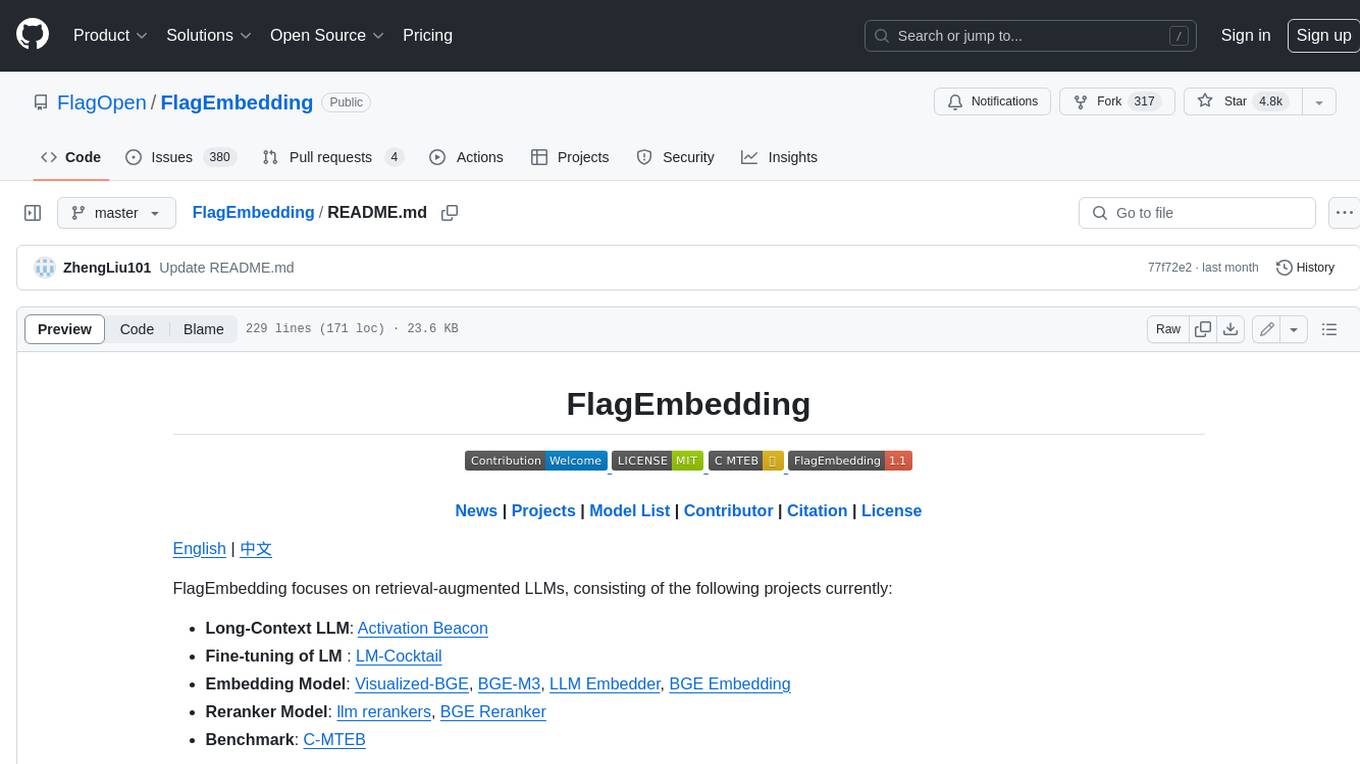
FlagEmbedding
FlagEmbedding focuses on retrieval-augmented LLMs, consisting of the following projects currently: * **Long-Context LLM** : Activation Beacon * **Fine-tuning of LM** : LM-Cocktail * **Embedding Model** : Visualized-BGE, BGE-M3, LLM Embedder, BGE Embedding * **Reranker Model** : llm rerankers, BGE Reranker * **Benchmark** : C-MTEB
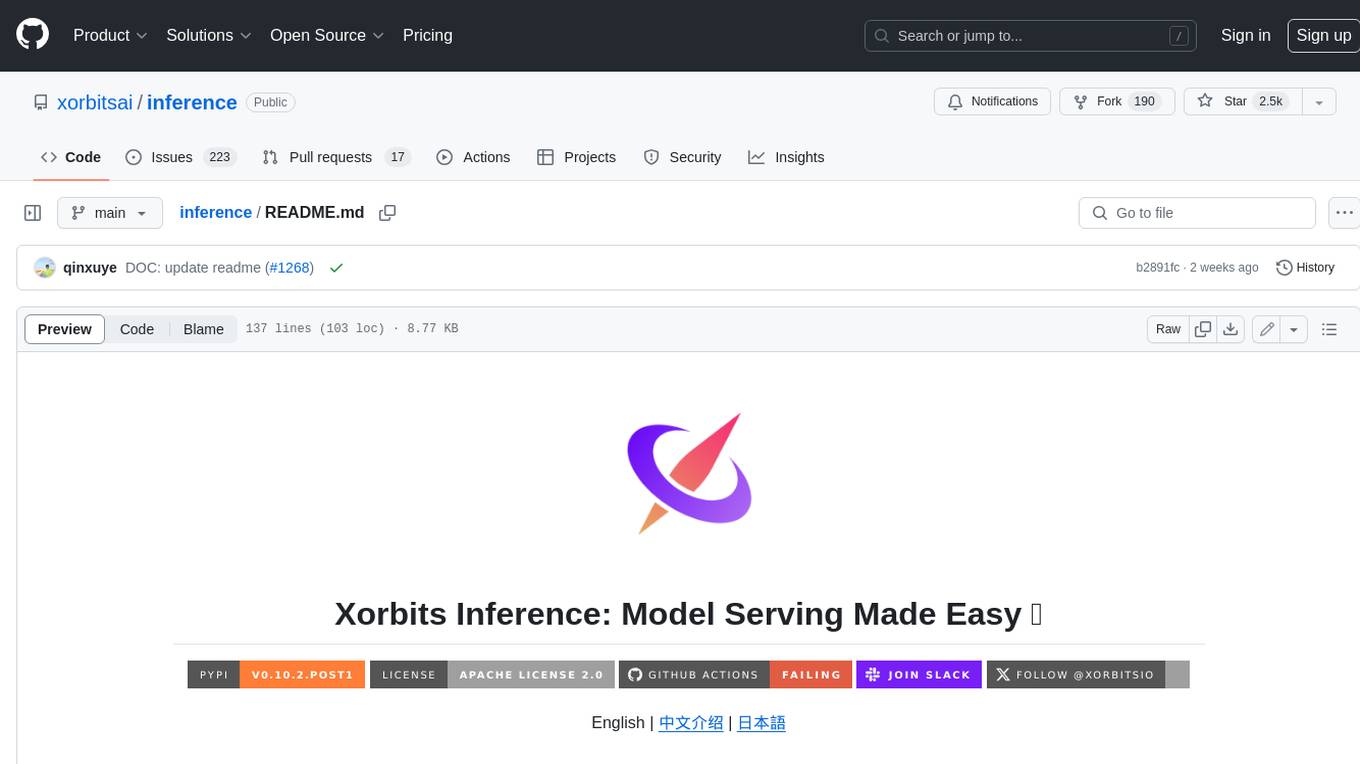
inference
Xorbits Inference (Xinference) is a powerful and versatile library designed to serve language, speech recognition, and multimodal models. With Xorbits Inference, you can effortlessly deploy and serve your or state-of-the-art built-in models using just a single command. Whether you are a researcher, developer, or data scientist, Xorbits Inference empowers you to unleash the full potential of cutting-edge AI models.
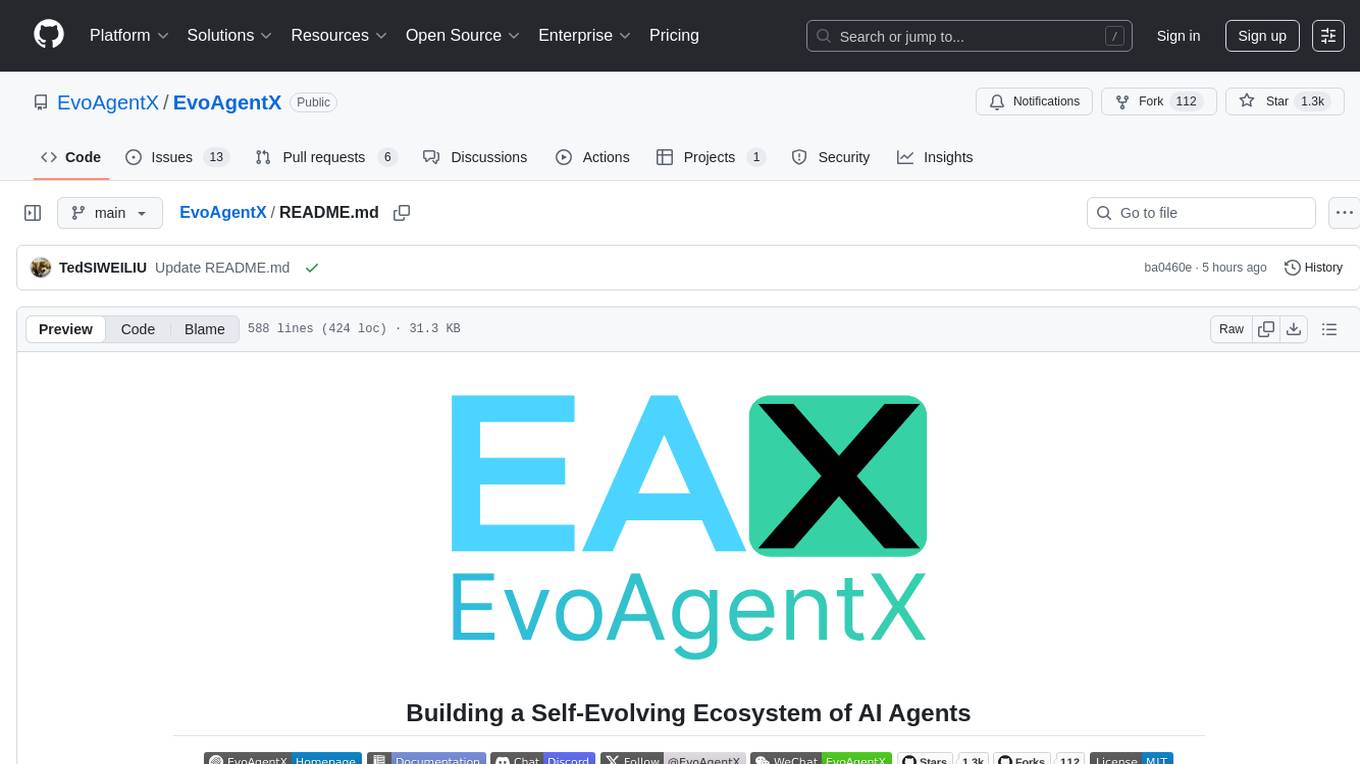
EvoAgentX
EvoAgentX is an open-source framework for building, evaluating, and evolving LLM-based agents or agentic workflows in an automated, modular, and goal-driven manner. It enables developers and researchers to move beyond static prompt chaining or manual workflow orchestration by introducing a self-evolving agent ecosystem. The framework includes features such as agent workflow autoconstruction, built-in evaluation, self-evolution engine, plug-and-play compatibility, comprehensive built-in tools, memory module support, and human-in-the-loop interactions.

auto-news
Auto-News is an automatic news aggregator tool that utilizes Large Language Models (LLM) to pull information from various sources such as Tweets, RSS feeds, YouTube videos, web articles, Reddit, and journal notes. The tool aims to help users efficiently read and filter content based on personal interests, providing a unified reading experience and organizing information effectively. It features feed aggregation with summarization, transcript generation for videos and articles, noise reduction, task organization, and deep dive topic exploration. The tool supports multiple LLM backends, offers weekly top-k aggregations, and can be deployed on Linux/MacOS using docker-compose or Kubernetes.
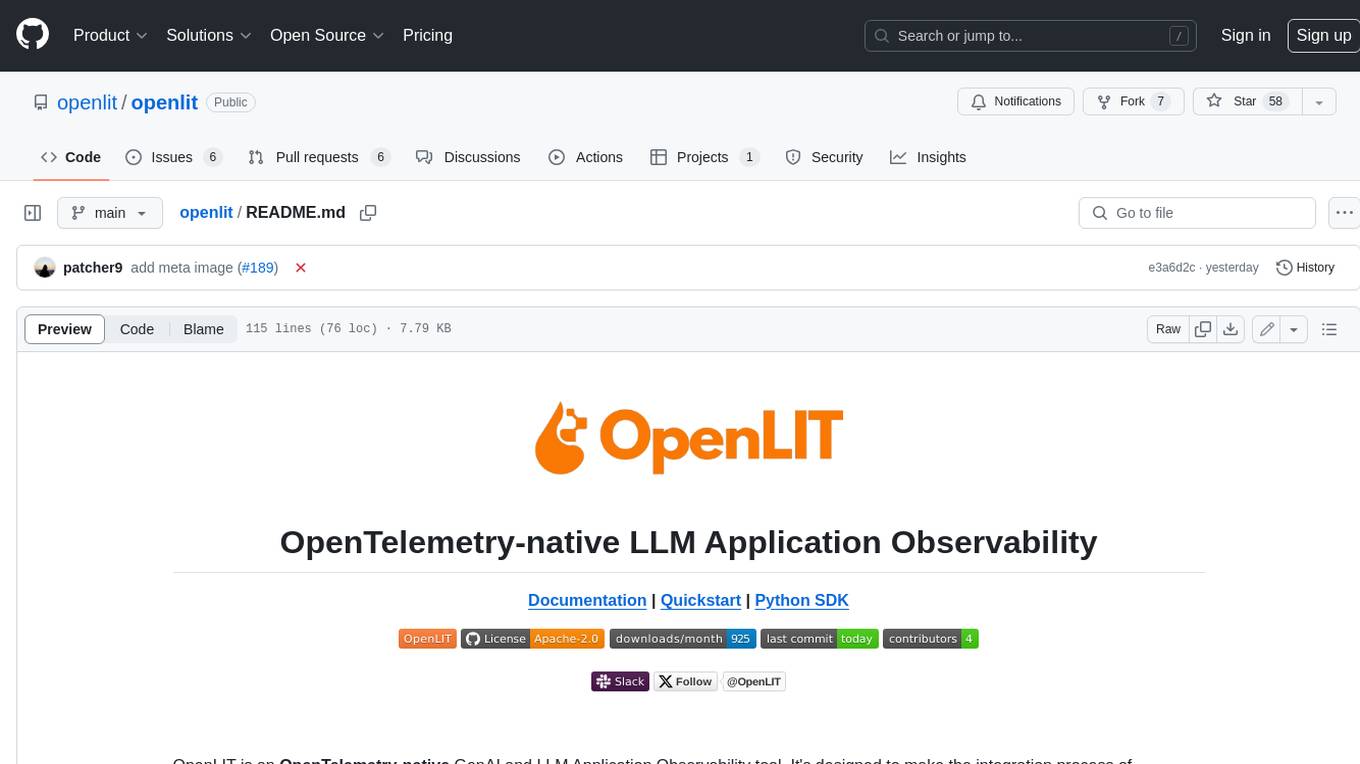
openlit
OpenLIT is an OpenTelemetry-native GenAI and LLM Application Observability tool. It's designed to make the integration process of observability into GenAI projects as easy as pie – literally, with just **a single line of code**. Whether you're working with popular LLM Libraries such as OpenAI and HuggingFace or leveraging vector databases like ChromaDB, OpenLIT ensures your applications are monitored seamlessly, providing critical insights to improve performance and reliability.
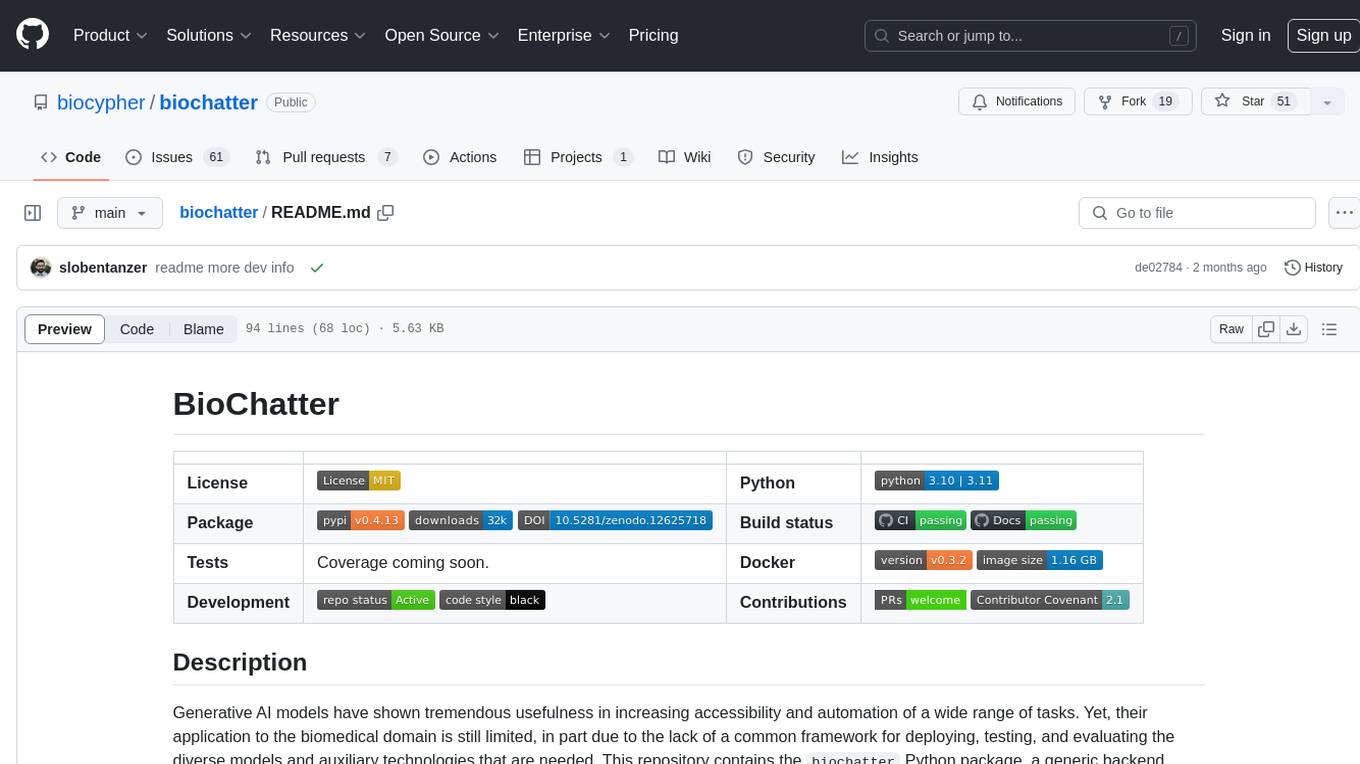
biochatter
Generative AI models have shown tremendous usefulness in increasing accessibility and automation of a wide range of tasks. This repository contains the `biochatter` Python package, a generic backend library for the connection of biomedical applications to conversational AI. It aims to provide a common framework for deploying, testing, and evaluating diverse models and auxiliary technologies in the biomedical domain. BioChatter is part of the BioCypher ecosystem, connecting natively to BioCypher knowledge graphs.
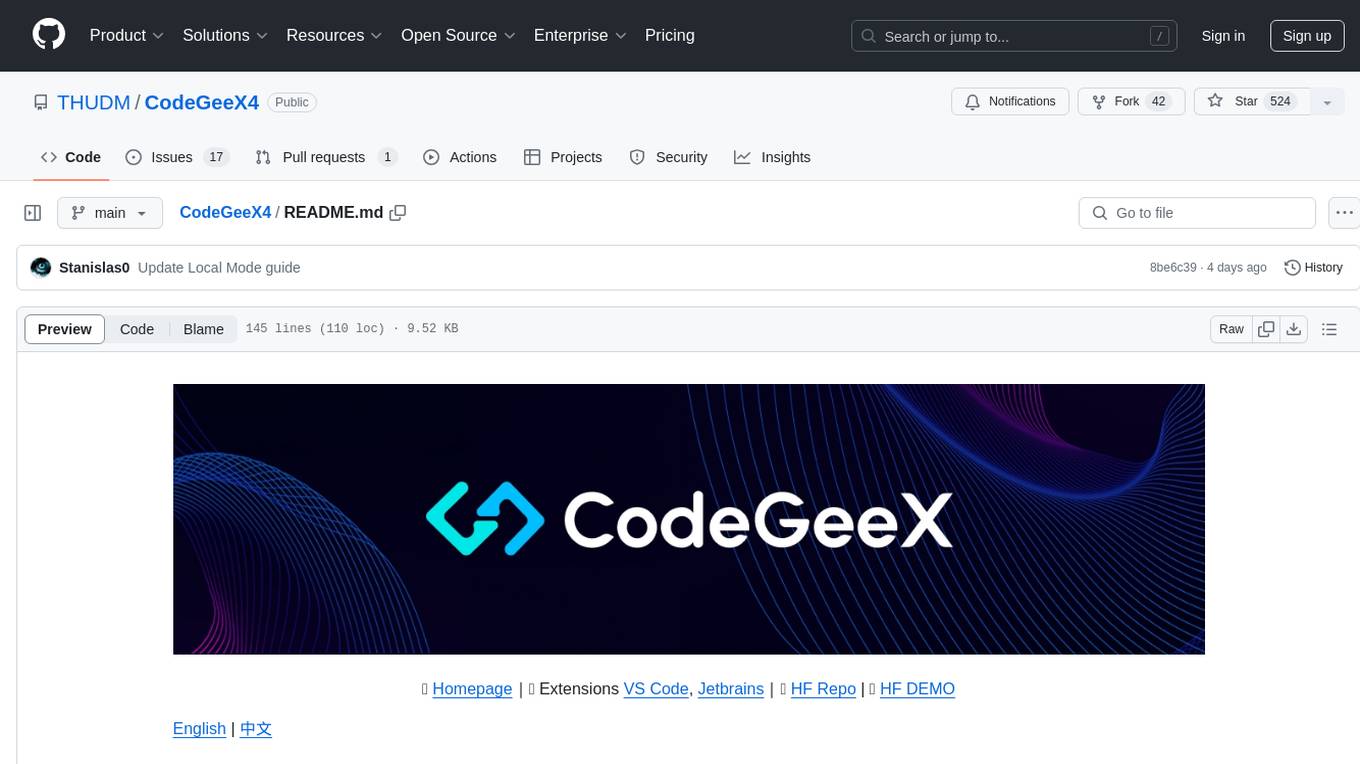
CodeGeeX4
CodeGeeX4-ALL-9B is an open-source multilingual code generation model based on GLM-4-9B, offering enhanced code generation capabilities. It supports functions like code completion, code interpreter, web search, function call, and repository-level code Q&A. The model has competitive performance on benchmarks like BigCodeBench and NaturalCodeBench, outperforming larger models in terms of speed and performance.

sailor-llm
Sailor is a suite of open language models tailored for South-East Asia (SEA), focusing on languages such as Indonesian, Thai, Vietnamese, Malay, and Lao. Developed with careful data curation, Sailor models are designed to understand and generate text across diverse linguistic landscapes of the SEA region. Built from Qwen 1.5, Sailor encompasses models of varying sizes, spanning from 0.5B to 7B versions for different requirements. Benchmarking results demonstrate Sailor's proficiency in tasks such as question answering, commonsense reasoning, reading comprehension, and more in SEA languages.
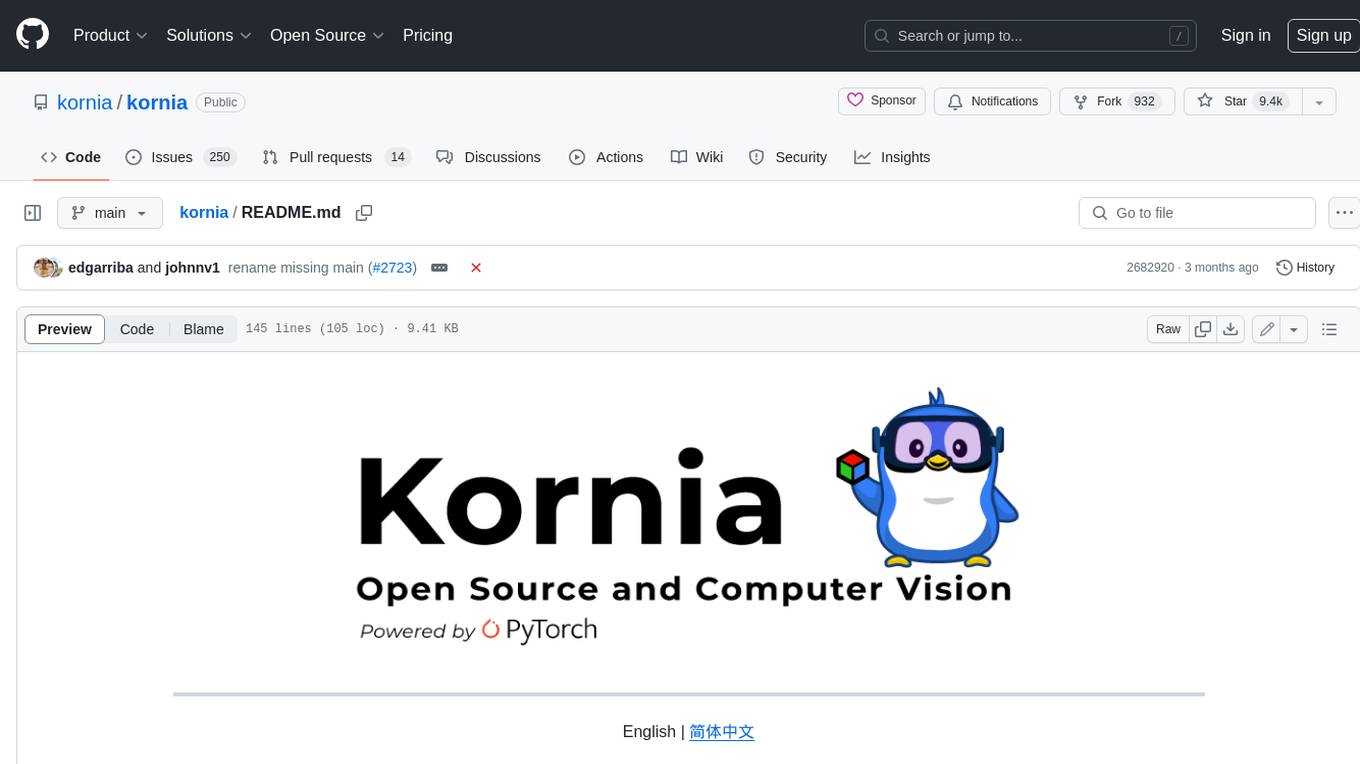
kornia
Kornia is a differentiable computer vision library for PyTorch. It consists of a set of routines and differentiable modules to solve generic computer vision problems. At its core, the package uses PyTorch as its main backend both for efficiency and to take advantage of the reverse-mode auto-differentiation to define and compute the gradient of complex functions.
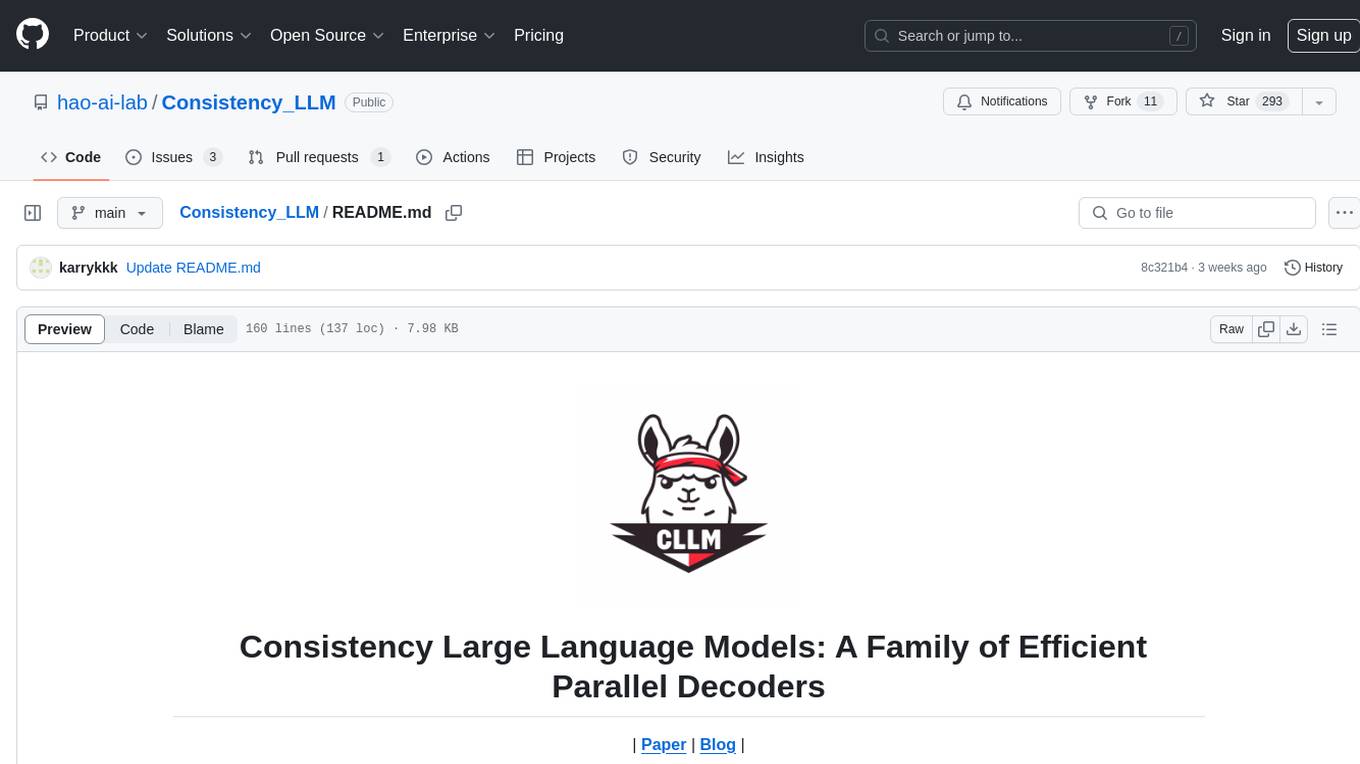
Consistency_LLM
Consistency Large Language Models (CLLMs) is a family of efficient parallel decoders that reduce inference latency by efficiently decoding multiple tokens in parallel. The models are trained to perform efficient Jacobi decoding, mapping any randomly initialized token sequence to the same result as auto-regressive decoding in as few steps as possible. CLLMs have shown significant improvements in generation speed on various tasks, achieving up to 3.4 times faster generation. The tool provides a seamless integration with other techniques for efficient Large Language Model (LLM) inference, without the need for draft models or architectural modifications.
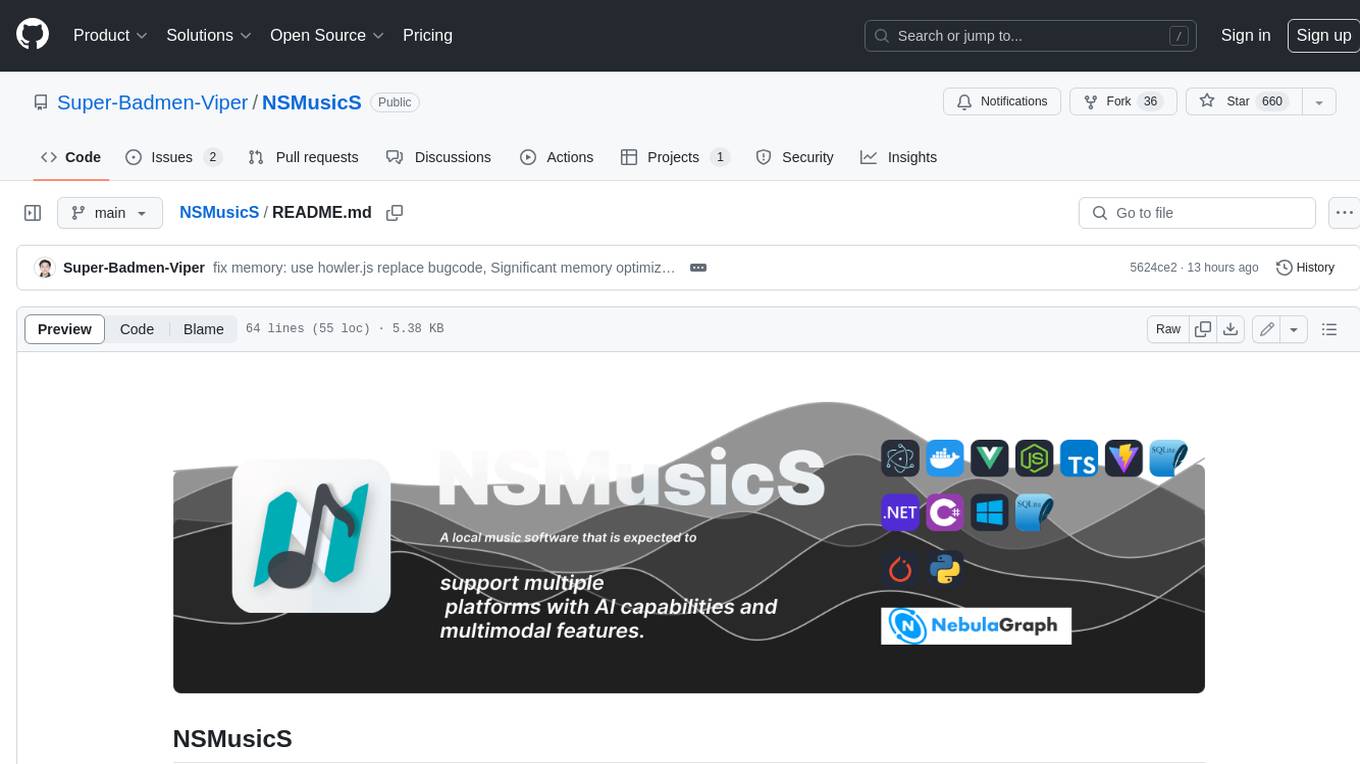
NSMusicS
NSMusicS is a local music software that is expected to support multiple platforms with AI capabilities and multimodal features. The goal of NSMusicS is to integrate various functions (such as artificial intelligence, streaming, music library management, cross platform, etc.), which can be understood as similar to Navidrome but with more features than Navidrome. It wants to become a plugin integrated application that can almost have all music functions.
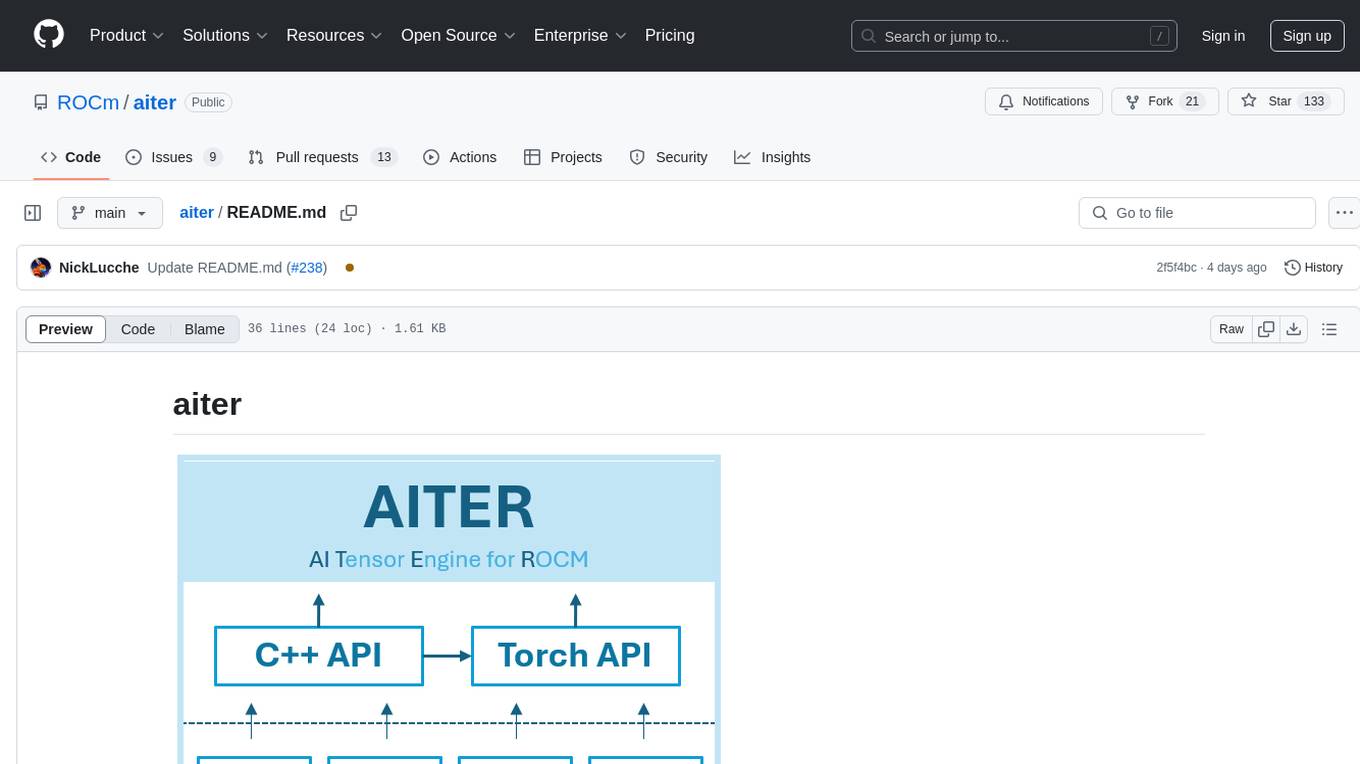
aiter
AITER is AMD’s centralized repository that supports various high performance AI operators for AI workloads acceleration. It serves as a unified platform for customer operator-level requests, catering to different customer needs. Developers can focus on operators and customers can integrate this collection into their own frameworks. Features include C++ and Python level APIs, kernels from triton/ck/asm, support for inference, training, GEMM, and communication kernels for workarounds in any kernel-framework combination for any architecture limitation.
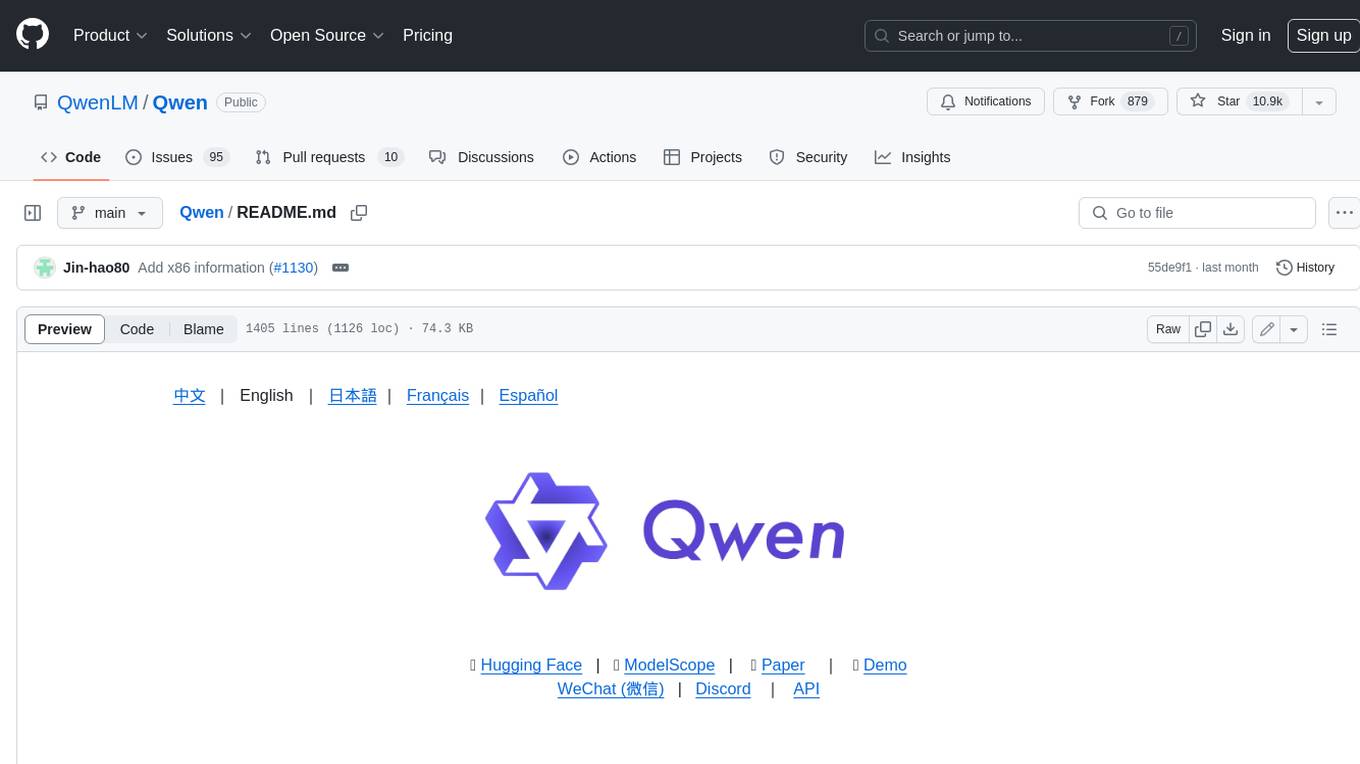
Qwen
Qwen is a series of large language models developed by Alibaba DAMO Academy. It outperforms the baseline models of similar model sizes on a series of benchmark datasets, e.g., MMLU, C-Eval, GSM8K, MATH, HumanEval, MBPP, BBH, etc., which evaluate the models’ capabilities on natural language understanding, mathematic problem solving, coding, etc. Qwen models outperform the baseline models of similar model sizes on a series of benchmark datasets, e.g., MMLU, C-Eval, GSM8K, MATH, HumanEval, MBPP, BBH, etc., which evaluate the models’ capabilities on natural language understanding, mathematic problem solving, coding, etc. Qwen-72B achieves better performance than LLaMA2-70B on all tasks and outperforms GPT-3.5 on 7 out of 10 tasks.
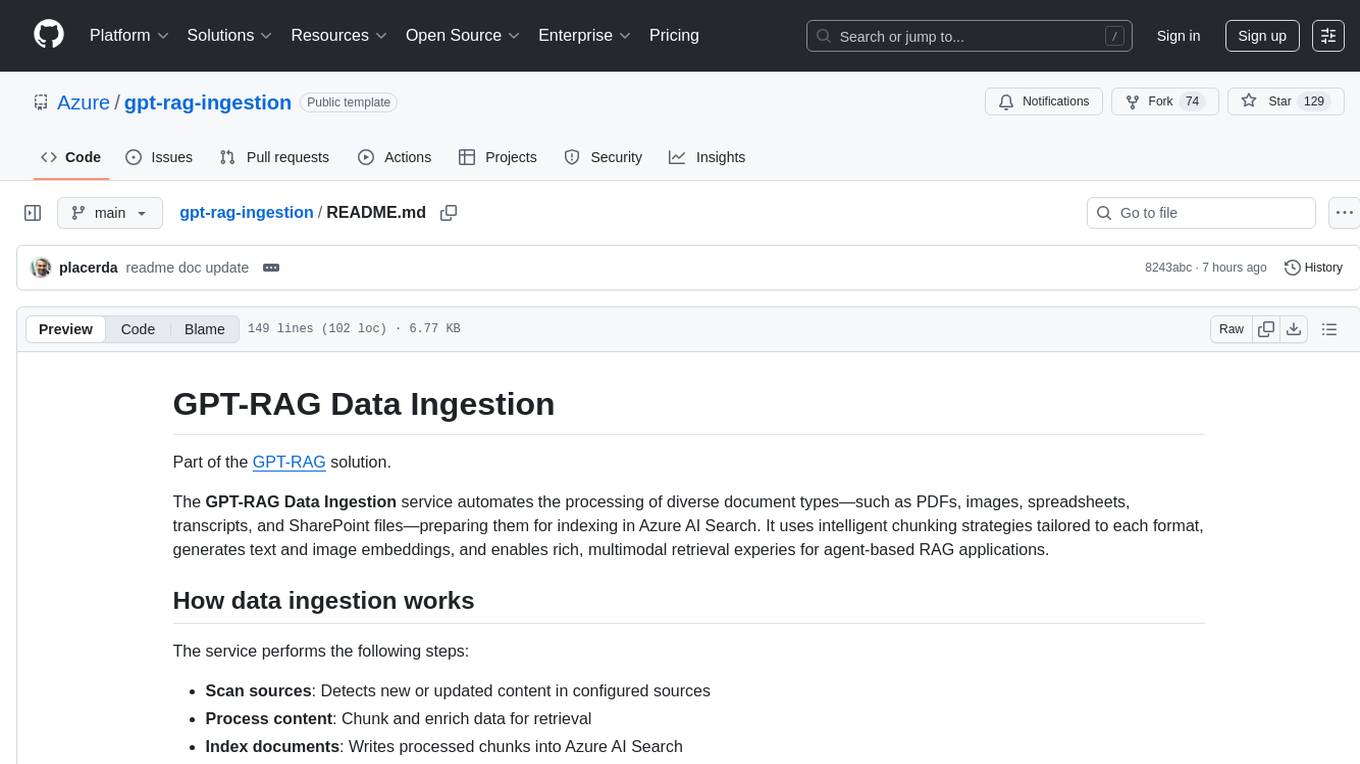
gpt-rag-ingestion
The GPT-RAG Data Ingestion service automates processing of diverse document types for indexing in Azure AI Search. It uses intelligent chunking strategies tailored to each format, generates text and image embeddings, and enables rich, multimodal retrieval experiences for agent-based RAG applications. Supported data sources include Blob Storage, NL2SQL Metadata, and SharePoint. The service selects chunkers based on file extension, such as DocAnalysisChunker for PDF files, OCR for image files, LangChainChunker for text-based files, TranscriptionChunker for video transcripts, and SpreadsheetChunker for spreadsheets. Deployment requires provisioning infrastructure and assigning specific roles to the user or service principal.
For similar tasks

openrl
OpenRL is an open-source general reinforcement learning research framework that supports training for various tasks such as single-agent, multi-agent, offline RL, self-play, and natural language. Developed based on PyTorch, the goal of OpenRL is to provide a simple-to-use, flexible, efficient and sustainable platform for the reinforcement learning research community. It supports a universal interface for all tasks/environments, single-agent and multi-agent tasks, offline RL training with expert dataset, self-play training, reinforcement learning training for natural language tasks, DeepSpeed, Arena for evaluation, importing models and datasets from Hugging Face, user-defined environments, models, and datasets, gymnasium environments, callbacks, visualization tools, unit testing, and code coverage testing. It also supports various algorithms like PPO, DQN, SAC, and environments like Gymnasium, MuJoCo, Atari, and more.
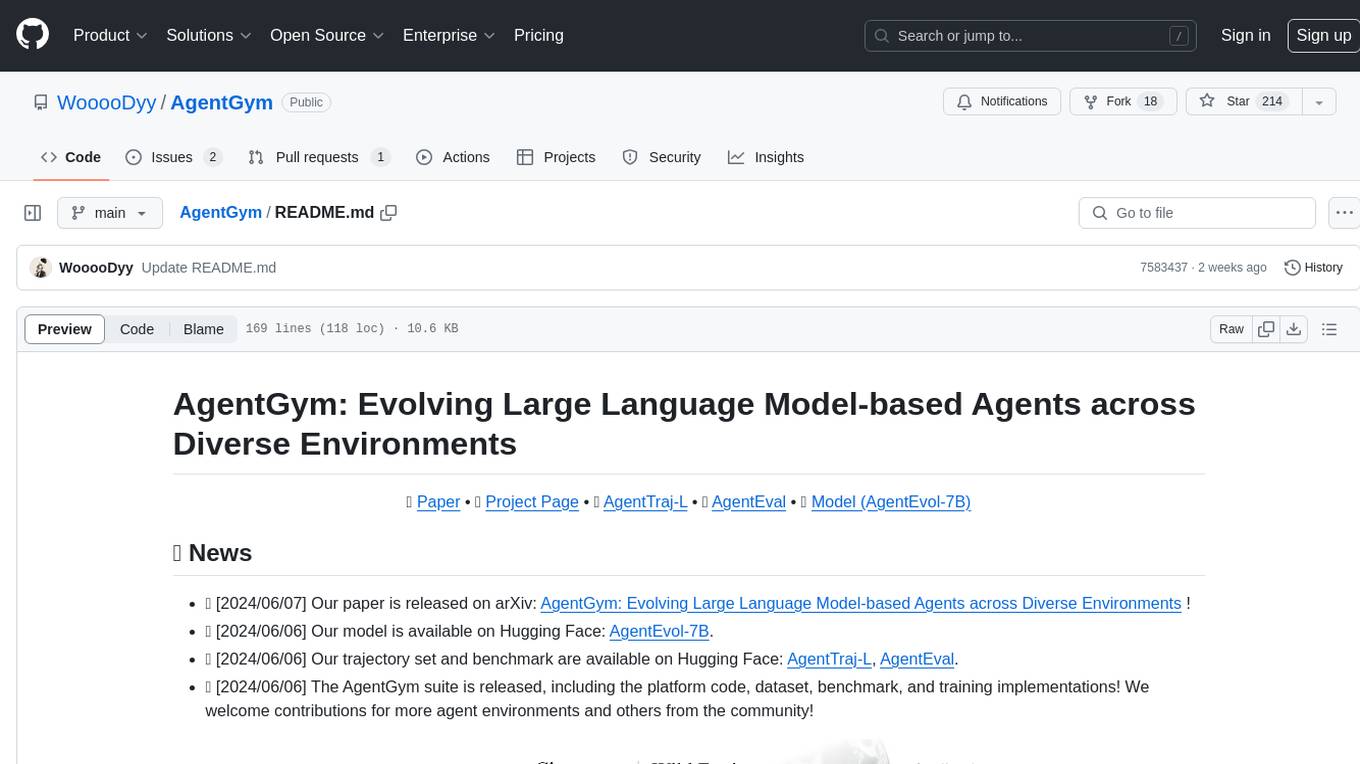
AgentGym
AgentGym is a framework designed to help the AI community evaluate and develop generally-capable Large Language Model-based agents. It features diverse interactive environments and tasks with real-time feedback and concurrency. The platform supports 14 environments across various domains like web navigating, text games, house-holding tasks, digital games, and more. AgentGym includes a trajectory set (AgentTraj) and a benchmark suite (AgentEval) to facilitate agent exploration and evaluation. The framework allows for agent self-evolution beyond existing data, showcasing comparable results to state-of-the-art models.
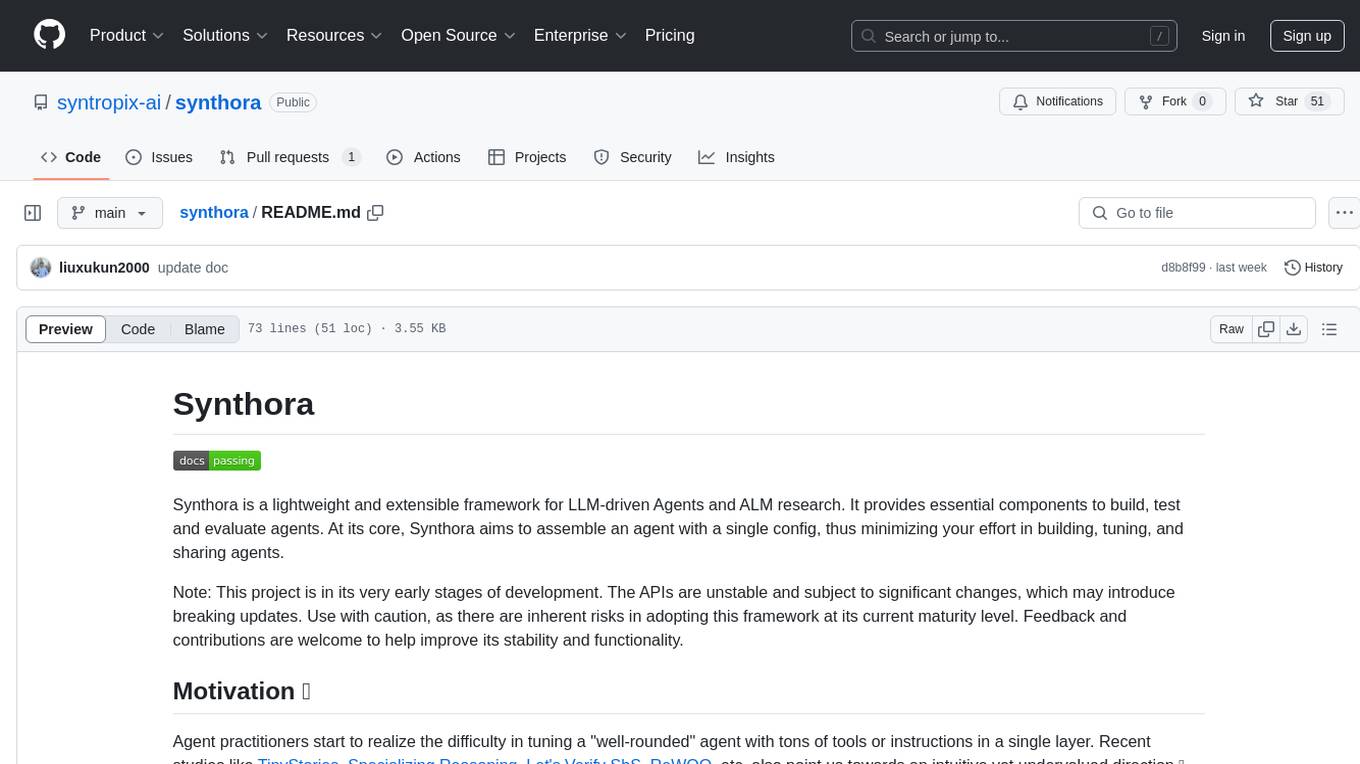
synthora
Synthora is a lightweight and extensible framework for LLM-driven Agents and ALM research. It aims to simplify the process of building, testing, and evaluating agents by providing essential components. The framework allows for easy agent assembly with a single config, reducing the effort required for tuning and sharing agents. Although in early development stages with unstable APIs, Synthora welcomes feedback and contributions to enhance its stability and functionality.
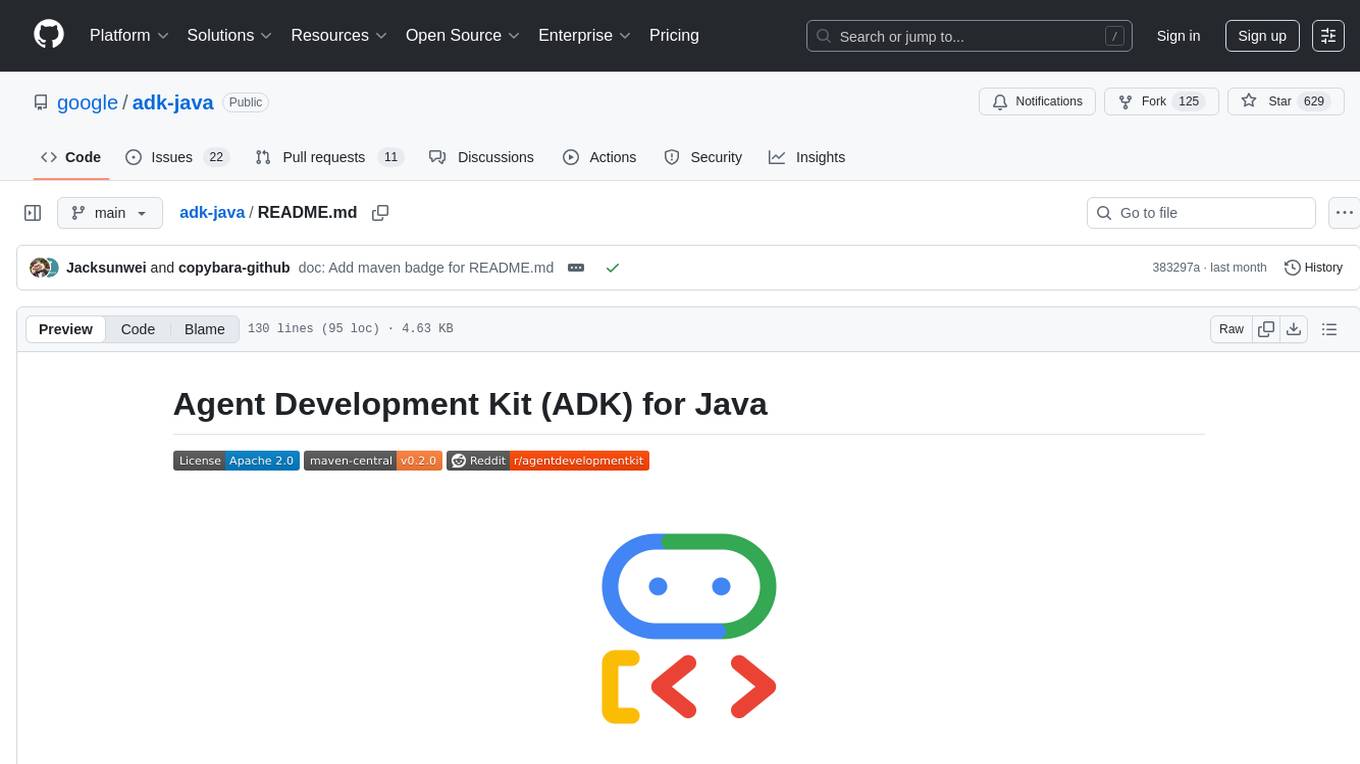
adk-java
Agent Development Kit (ADK) for Java is an open-source toolkit designed for developers to build, evaluate, and deploy sophisticated AI agents with flexibility and control. It allows defining agent behavior, orchestration, and tool use directly in code, enabling robust debugging, versioning, and deployment anywhere. The toolkit offers a rich tool ecosystem, code-first development approach, and support for modular multi-agent systems, making it ideal for creating advanced AI agents integrated with Google Cloud services.
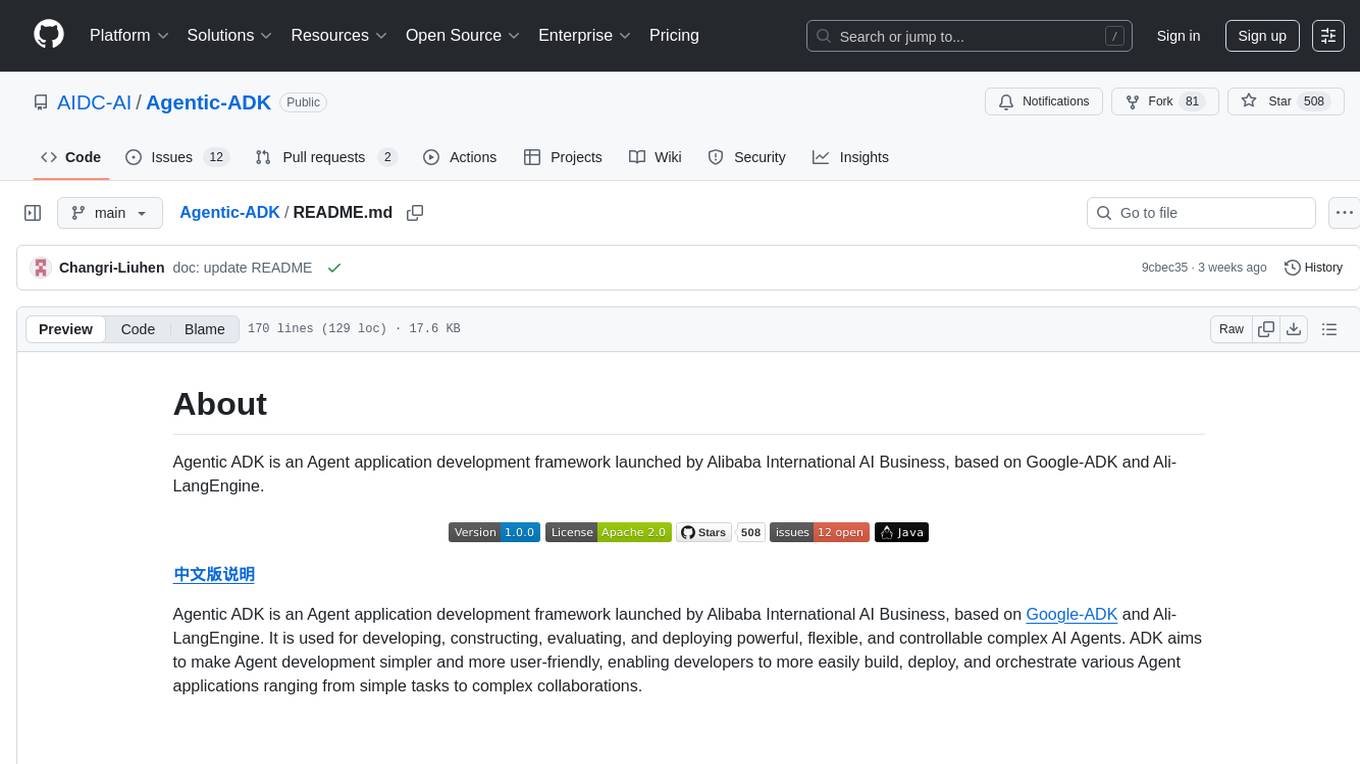
Agentic-ADK
Agentic ADK is an Agent application development framework launched by Alibaba International AI Business, based on Google-ADK and Ali-LangEngine. It is used for developing, constructing, evaluating, and deploying powerful, flexible, and controllable complex AI Agents. ADK aims to make Agent development simpler and more user-friendly, enabling developers to more easily build, deploy, and orchestrate various Agent applications ranging from simple tasks to complex collaborations.
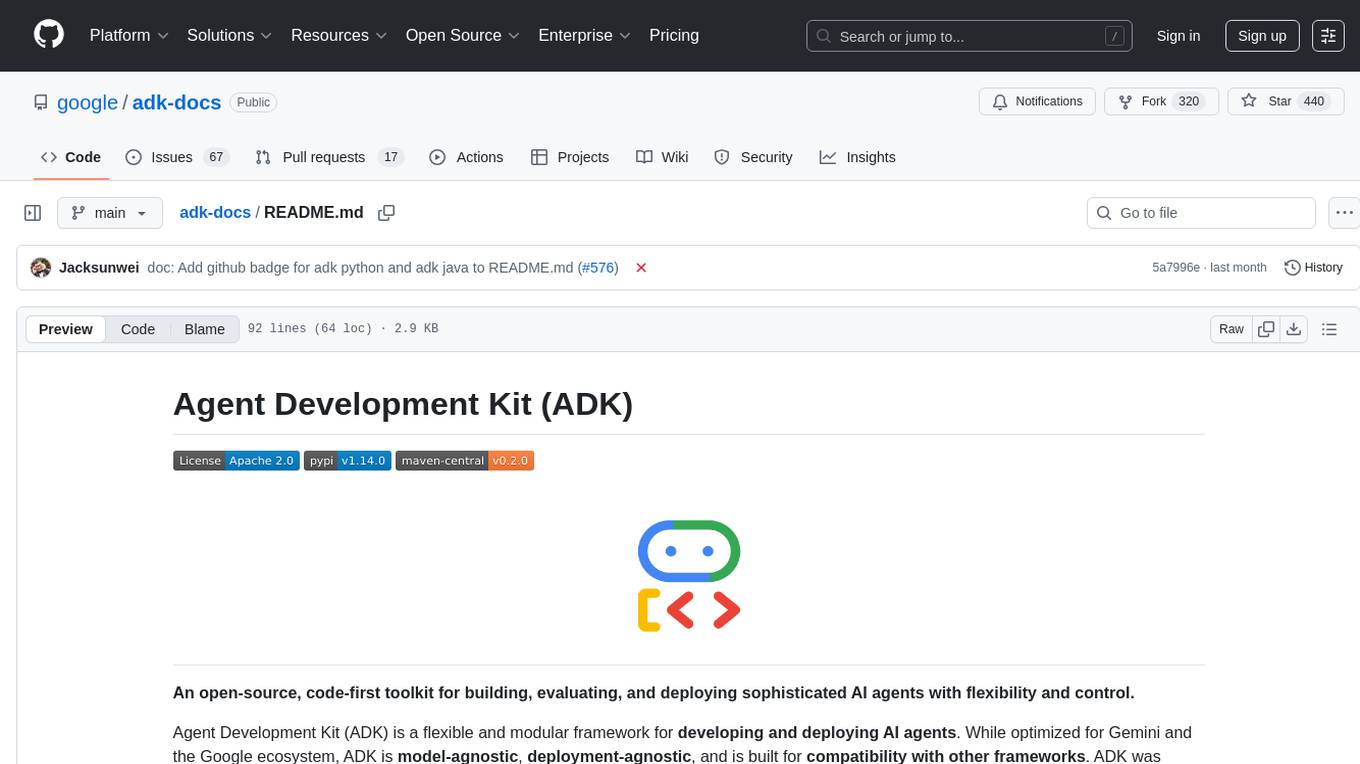
adk-docs
Agent Development Kit (ADK) is an open-source, code-first toolkit for building, evaluating, and deploying sophisticated AI agents with flexibility and control. It is a flexible and modular framework optimized for Gemini and the Google ecosystem, model-agnostic, deployment-agnostic, and compatible with other frameworks. ADK simplifies agent development by making it feel more like software development, enabling developers to create, deploy, and orchestrate agentic architectures from simple tasks to complex workflows.
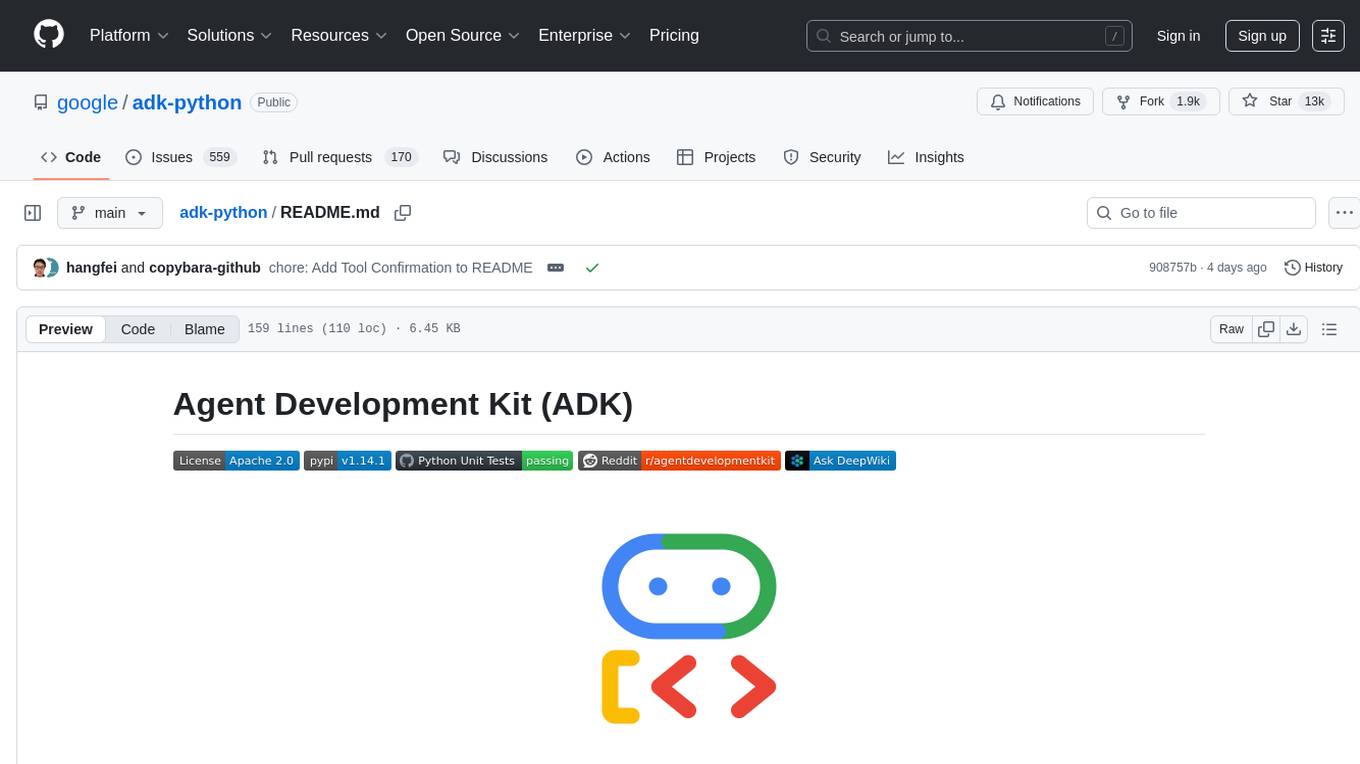
adk-python
Agent Development Kit (ADK) is an open-source, code-first Python toolkit for building, evaluating, and deploying sophisticated AI agents with flexibility and control. It is a flexible and modular framework optimized for Gemini and the Google ecosystem, but also compatible with other frameworks. ADK aims to make agent development feel more like software development, enabling developers to create, deploy, and orchestrate agentic architectures ranging from simple tasks to complex workflows.
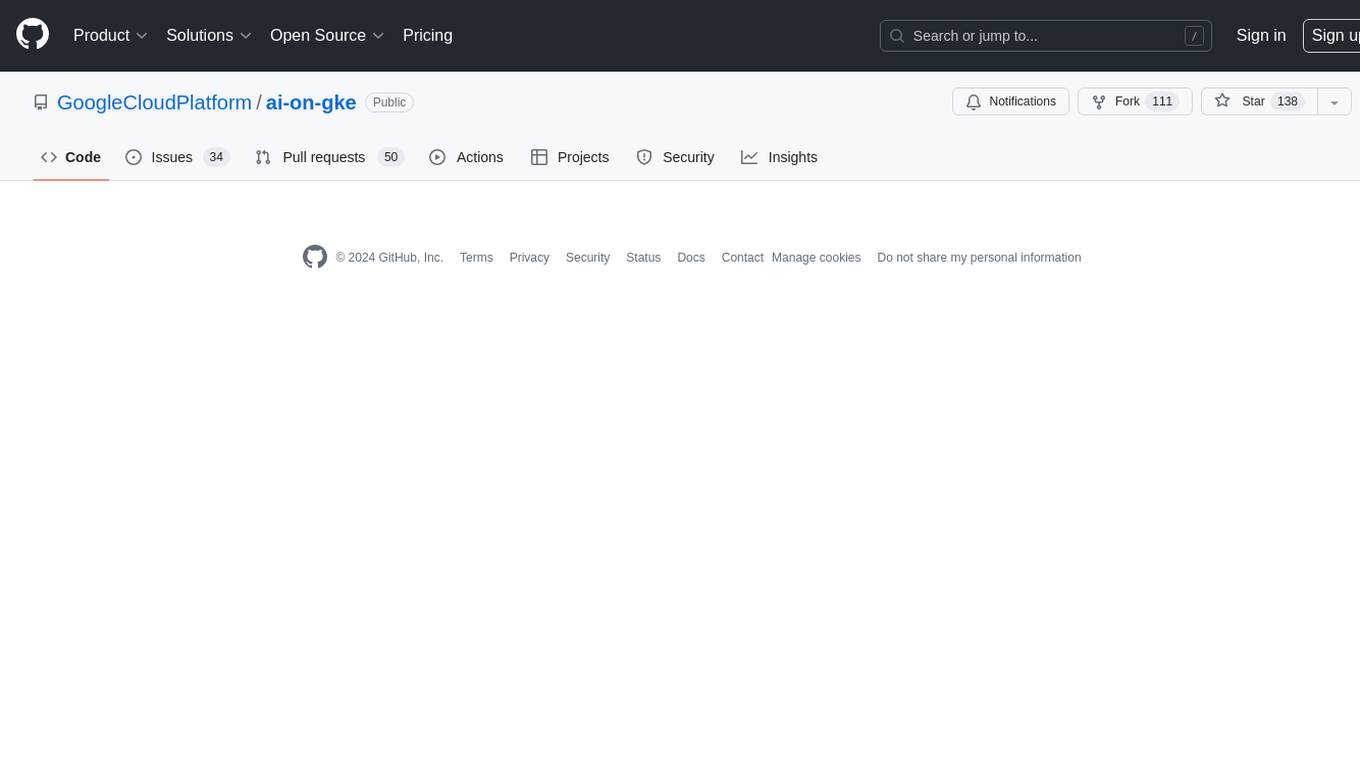
ai-on-gke
This repository contains assets related to AI/ML workloads on Google Kubernetes Engine (GKE). Run optimized AI/ML workloads with Google Kubernetes Engine (GKE) platform orchestration capabilities. A robust AI/ML platform considers the following layers: Infrastructure orchestration that support GPUs and TPUs for training and serving workloads at scale Flexible integration with distributed computing and data processing frameworks Support for multiple teams on the same infrastructure to maximize utilization of resources
For similar jobs

weave
Weave is a toolkit for developing Generative AI applications, built by Weights & Biases. With Weave, you can log and debug language model inputs, outputs, and traces; build rigorous, apples-to-apples evaluations for language model use cases; and organize all the information generated across the LLM workflow, from experimentation to evaluations to production. Weave aims to bring rigor, best-practices, and composability to the inherently experimental process of developing Generative AI software, without introducing cognitive overhead.

LLMStack
LLMStack is a no-code platform for building generative AI agents, workflows, and chatbots. It allows users to connect their own data, internal tools, and GPT-powered models without any coding experience. LLMStack can be deployed to the cloud or on-premise and can be accessed via HTTP API or triggered from Slack or Discord.

VisionCraft
The VisionCraft API is a free API for using over 100 different AI models. From images to sound.

kaito
Kaito is an operator that automates the AI/ML inference model deployment in a Kubernetes cluster. It manages large model files using container images, avoids tuning deployment parameters to fit GPU hardware by providing preset configurations, auto-provisions GPU nodes based on model requirements, and hosts large model images in the public Microsoft Container Registry (MCR) if the license allows. Using Kaito, the workflow of onboarding large AI inference models in Kubernetes is largely simplified.

PyRIT
PyRIT is an open access automation framework designed to empower security professionals and ML engineers to red team foundation models and their applications. It automates AI Red Teaming tasks to allow operators to focus on more complicated and time-consuming tasks and can also identify security harms such as misuse (e.g., malware generation, jailbreaking), and privacy harms (e.g., identity theft). The goal is to allow researchers to have a baseline of how well their model and entire inference pipeline is doing against different harm categories and to be able to compare that baseline to future iterations of their model. This allows them to have empirical data on how well their model is doing today, and detect any degradation of performance based on future improvements.

tabby
Tabby is a self-hosted AI coding assistant, offering an open-source and on-premises alternative to GitHub Copilot. It boasts several key features: * Self-contained, with no need for a DBMS or cloud service. * OpenAPI interface, easy to integrate with existing infrastructure (e.g Cloud IDE). * Supports consumer-grade GPUs.

spear
SPEAR (Simulator for Photorealistic Embodied AI Research) is a powerful tool for training embodied agents. It features 300 unique virtual indoor environments with 2,566 unique rooms and 17,234 unique objects that can be manipulated individually. Each environment is designed by a professional artist and features detailed geometry, photorealistic materials, and a unique floor plan and object layout. SPEAR is implemented as Unreal Engine assets and provides an OpenAI Gym interface for interacting with the environments via Python.

Magick
Magick is a groundbreaking visual AIDE (Artificial Intelligence Development Environment) for no-code data pipelines and multimodal agents. Magick can connect to other services and comes with nodes and templates well-suited for intelligent agents, chatbots, complex reasoning systems and realistic characters.
















